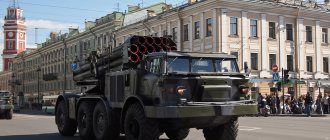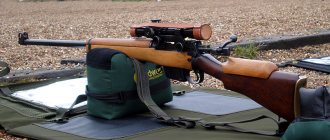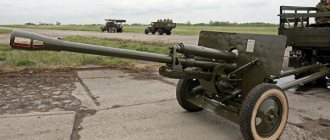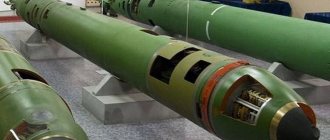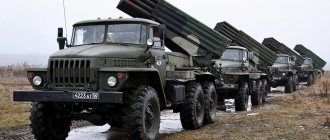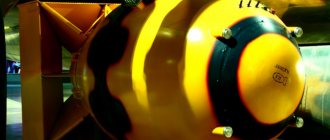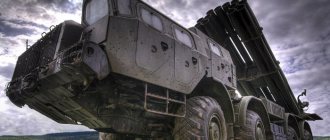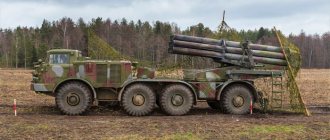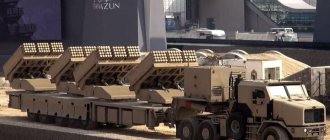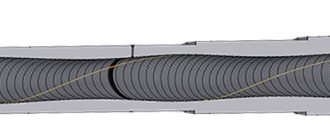The conflict could not be resolved peacefully, since Beijing insisted on observing the decisions of the Paris Conference of 1919 on consolidating the passage of the interstate border along the middle of the main fairway of the river dividing the powers - the Ussuri. The USSR, in turn, referred to the historical Treaty of Beijing, signed by the Celestial Empire at the moment of its greatest weakening, in 1860.
As a result, the issue was resolved through negotiations in September 1969 at the Beijing airport, in the hall of government delegations, between the Chairman of the USSR Cabinet of Ministers, Alexei Kosygin, and his Chinese counterpart, Zhou Enlai. However, another actor was also present invisibly at the negotiating table - the defense department of the USSR, which managed to show the PRC in practice what the expression means -
MLRS BM-21 Grad. Damage area. Rockets. Caliber. Story
Having become an important stage in the history of the development of rocket artillery, the BM-21 Grad MLRS was developed on its own initiative at the Tula Scientific Research Institute-147, created in July 1945 to solve the problems of technological support for the mass production of cartridges for conventional artillery rounds. The technology for manufacturing sleeves developed by NII-147 using deep drawing also ensured the production of thicker-walled and stronger shells, which are the combustion chambers of rocket engines. Therefore, the designers of NII-147 had the opportunity to move from solving a particular problem - technological support for the production of ammunition - to a more complex and comprehensive one - the development of a multiple launch rocket system.
"Katyusha"
During the Great Patriotic War, field artillerymen acquired barrelless systems, unofficially called “Katyushas”. Initially they were manufactured as BM-13, and then as BM-8, BM-31 and so on.
The armed forces of the USSR very actively used these installations during the Second World War. The nickname “Katyusha” was quite popular, so the BM-21 “Grad”, post-war MLRS on a vehicle chassis, and the BM-14 began to be called this colloquially.
Later, Soviet artillerymen dubbed other installations with similar nicknames (“Vanyusha”, “Andryusha”): BM-31 and others. Of course, these names are not so famous.
BM-21 Grad MLRS salvo - video
Conducted under the leadership of A.N. Ganichev's work was supported by the order of the Chairman of the State Committee for Defense Technology dated February 24, 1959 and the Resolution of the Council of Ministers of May 30, 1960, and the tactical and technical requirements for the system were approved on October 10, 1960. In accordance with the Resolution of the Council of Ministers, the creation of a rocket M-21OF and PCZO as a whole were entrusted to NII-147, the propellant charge of the engine was developed by NII-6, and the warhead of the projectile was developed by GSKB-47. The BM-21 (2B5) combat vehicle was assigned to design the SKB-203. Fire bench tests of rocket engines began already in 1960, with 53 burns carried out as part of factory tests and 81 at state tests. Test launches soon began.
State testing grounds began on March 1, 1962 and were carried out using two combat vehicles at the Rzhevsk training ground near Leningrad. During their implementation, there were breakdowns of the combat vehicle. To eliminate their prerequisites, the rear axle of the chassis was strengthened by using alloy steels. In addition, they limited themselves to disabling the suspension of only one of the chassis axles instead of the previously performed similar operation with both rear axles. This turned out to be enough to give the combat vehicle the necessary stability when firing, and the loads did not exceed the permissible level. By the Decree of the Council of Ministers of March 28, 1963, the BM-21 Grad multiple launch rocket system was adopted for service, and in accordance with the Decree of January 29, 1964 No. 98-32 was transferred into mass production. In fact, the system began to enter service only the following year, when serial production of the chassis for the BM-21 - Ural-375D - was launched in Miass.
The scale of production of the USSR BM-21 is impressive: about 3 thousand BM-21 and more than 3 million shells for them were manufactured at the Motovilikha plants alone. The release of this system and its modifications was also launched in China, Egypt, Iraq, Iran, Romania and South Africa. Currently, the BM-21 is in service with the armies of more than 30 countries. At the beginning of 1994, there were 4,500 BM-21 MLRS in the Armed Forces of the Russian Federation and about 3,000 in the armies of other countries. The BM-21 MLRS consists of a launcher, 122-mm unguided rockets, a fire control system and a transport-loading vehicle. To prepare data for firing, the BM-21 MLRS battery includes a 1V110 “Beryza” control vehicle on a GAZ-66 vehicle chassis.
The BM-21 launcher is designed according to the classical design with the artillery unit placed in the rear of the vehicle chassis. The artillery unit is a package of 40 tubular guides mounted on a rotating base with the ability to aim in vertical and horizontal planes. The artillery unit also includes lifting and turning mechanisms. sighting devices and corresponding pneumatic, electrical and radio equipment. The guides are arranged in four rows of ten pipes each, thus forming a package. The package, together with sighting devices, is mounted on a rigid welded cradle. Guidance mechanisms allow you to direct the package of guides in the vertical plane in the angle range from 0° to +55°. The angle of horizontal missile fire is 172° (102° to the left of the longitudinal axis of the vehicle and 70° to the right). The main method of guidance is from an electric drive.
For the BM-21 MLRS, a 122-mm unguided rocket was developed, the design of which had a revolutionary effect on the development of post-war rocket artillery. At the suggestion of the chief designer of NII-147 A.N. Ganichev, the projectile body is made not by traditional cutting from a steel blank, but by a high-performance method of rolling and drawing from a steel sheet. Another feature of the BM-21 MLRS rocket is the folding planes of the stabilizer, which are held in the closed position by a special ring and do not extend beyond the dimensions of the projectile. The folding stabilizer itself was not an invention of Tula designers. For example, such a stabilizer was used in the German unguided aircraft rocket R4M, the numerous elongated stabilizer feathers of which, in the folded position, occupied the space around a specially elongated engine nozzle, and after the rocket exited the launcher, they leaned back, forming a kind of broom rod. However, this design required an artificial lengthening of the rocket nozzle, thereby increasing its weight and dimensions. A different scheme was adopted in the design of the Grad system rocket. The stabilizer feather was not made flat, but in the shape of a cylinder sector, curved when viewed from the front along an arc with a radius close to half the diameter of the rocket. The developers called this shape a “crow’s wing.” In the folded position, the surfaces of the stabilizers seemed to continue the cylinder of the rocket engine housing. The opening of the block of stabilizers, held by a ring before launch, was carried out by a spring mechanism. In the open position, the stabilizer blades were rotated 1° relative to the plane passing through the longitudinal axis of the rocket, which provided twist relative to this axis to reduce the influence of thrust eccentricities and the center of mass.
Otherwise, the layout of the rocket projectile is quite traditional: in the front part, behind the head contact fuse, there is a warhead, to which an engine body made of steel is adjacent. Due to the high elongation, the body consists of two cylindrical sections connected by threads. The nozzle block includes a central and six peripheral nozzles. In the supersonic part, the nozzles have a cone shape with an angle of 30°. The diameter of the critical section of the nozzle is 19 mm, the cut-off diameter is 37 mm.
A 0.3 mm thick heat-protective coating applied to the inner surface of the engine body not only protects the steel body from heating and a corresponding decrease in strength, but also significantly reduces energy losses from burning fuel and contributes to obtaining a high specific impulse and increased combustion rate. For technological reasons, the solid fuel charge is also made of two half-charges. In this case, the tail semi-charge has a larger gap between the walls of the housing and the fuel, since it is necessary to provide a sufficient flow area for the fuel combustion products of both the front and tail semi-charges.
Due to the fact that during long-term storage of shells in a horizontal position, deformation of the engine body was not excluded, the fuel charge was separated from the walls of the engine chamber by a gap of 4 mm for the head half-charge and 9 mm for the tail half-charge. The half-charges were fixed by means of six “crackers” measuring 50 x 10 mm, made from the same fuel, glued to each of them. The ends of the half-charges were armored with glued nitrolinoleum washers.
The fuel charge used the RSI-12M recipe, previously developed by NII-6 employee BC Lernov and consisting of 56% xylidine. 26.7% nitroglycerin. 10.5% dinitrotoluene. 3% centrality. The charge also included catalysts and technological additives. Between the semi-charges there was an igniter with 80 g of coarse black powder KZDP-1 and 2 g of DRP-1 gunpowder, located in separate percale bags. Current was supplied to two MB-2N electric igniters through wires laid through the central nozzle and the tail semi-charge channel. The total mass of two half-charges with “crackers” and washers was 20.6 kg, the missile body was 24.5 kg (with stabilizers - 26.4 kg).
The production of half-charges was carried out on a specially designed automatic production line. It provided automatic formation of half-charges, their overloading, geometry control, weighing, gluing of “crackers” and end washers, and marking. The packaging of half-charges into containers was carried out in a semi-automatic mode. Gradually, the technology for manufacturing and operating charges was simplified. Tolerances for foreign and air inclusions were expanded, and storage of charges in unsealed containers began to be allowed. At the end of the sixties, the production of a charge from denser RST-4K fuel was tested, which made it possible, while maintaining the required mass, to slightly reduce the size and unify the geometry of half-charges. Instead of glued “crackers”, small protrusions were used - ridges on the outer surface, formed during the process of making checkers. Somewhat later, the production of fuel half-charges was mastered using a special recipe, in the manufacture of which products from the processing of fuel charges extracted from obsolete rockets with an expired warranty period were used. The production of such charges with zigs, without glued “crackers”, from reworking recipes was carried out in 1975-1980.
The powder charge of the projectile is ignited by igniters, triggered by current pulses from the current distributor of the fire control system. The duration of a salvo of one BM-21 is 20 seconds. If necessary, a salvo could be fired not from the cockpit, but from a remote control panel located several tens of meters away. The most widely used type of BM-21 MLRS rocket is the M-210F (9M22U) projectile with a high-explosive fragmentation warhead. The length of this projectile with the MRV-U fuse is 2.87 m. The weight with the fuse is 66.4 kg, the weight of the warhead is 19.18 kg, and the weight of the explosive is 6.4 kg.
The powder charge (RSI gunpowder - 12 m) weighing 20.45 kg provides the highest projectile flight speed of 690 m/s. The fuse is cocked after leaving the guide at distances of 150-450 m from the combat vehicle. The nature of the projectile’s action at the target depends on the installation of the fuse: with instantaneous operation, it is predominantly fragmentation; with delayed operation, it is predominantly high-explosive. In terms of fragmentation action, the warhead of the M-21 OF projectile is twice as effective as the M-140F, and in terms of high-explosive action it is only 1.7 times more effective, which is reflected in the greater elongation of the new rocket projectile. Accuracy in the firing direction was 1/180, in the lateral direction - 1/110 of the range.
When launched at a range of 20 km, half of the hits fell within a distance of 200-300 m relative to the center of the grouping of explosions. The maximum speed of the rocket was about 690 m/s. To maintain acceptable accuracy when firing at ranges from 12 to 15.9 km, a small brake ring was attached between the head fuse and the warhead of the missile, and a large one for shorter ranges. As a result, launches were carried out without using extremely steep or flat trajectories, the use of which is associated with large dispersion of projectiles. A salvo of one combat vehicle provided a destruction area of about 1000 m2 for manpower, and 840 m2 for unarmored vehicles.
Where is it used today?
It is believed that the Grad system, the characteristics of which are described in the article, is in service in thirty countries around the world, but in fact their number is much larger. As for the Russian Federation, the state troops have 2.5 thousand installations, of which 350 are on combat duty, and the rest are mothballed.
There are about forty Grads on duty in the coastal defense forces. According to statistics, there are at least three thousand BM-21 Grad in the armies of the world. The multiple launch rocket system, the characteristics of which are impressive, immediately spread throughout the world. In principle, such a number of MLRS is not at all surprising, since at the Motovilikha plants in Perm this installation was produced for many years, and in large quantities.
But “Grad” was produced not only there! In Perm alone, three thousand BM-21 units came off the stocks. At least three million shells for them were manufactured there. But that’s not all “Grad”! The multiple launch rocket system, photos of which are presented in the article, was repeatedly modernized by foreign countries, which in some cases managed to create decent weapons.
You don't have to look far for examples. Thus, more than one hundred Grad vehicles remain on the territory of Ukraine. The multiple launch rocket system, which Ukraine badly needed, was transferred to the KRAZ vehicle chassis, which made it possible to avoid dependence on the supply of spare parts.
Missiles
9M22 - high-explosive fragmentation projectile
9M22U - improved high-explosive fragmentation projectile;
9M22S - incendiary projectile;
9M23 - chemical fragmentation projectile, which in terms of basic flight performance characteristics corresponds to the M22S projectile;
9M28F - high-explosive fragmentation projectile with a detachable warhead;
9M521 - high-explosive fragmentation projectile
9M522 - high-explosive fragmentation projectile
9M28D - propaganda shell;
9M43 - smoke-smoking projectile (ten projectiles of this type create a continuous curtain of smoke over an area of 50 hectares);
9M42 - lighting projectile for the Illumination system;
9M28K - a projectile with a cassette warhead with PTM-3 anti-tank mines;
ZM16 - a projectile with a cassette warhead with POM-2 anti-personnel mines (forty projectiles of this type mine one kilometer of front);
9M519-1-7 (“Lily-2”) - a set of projectiles for radio interference in the HF and VHF bands. as well as other types of projectiles.
"Threat-1M" - guided projectile
Countries that produce this system under license or illegally are also actively developing new ammunition for the BM-21.
The BM-21 artillery unit includes a package of 40 tubular guides with an internal diameter of 122.4 mm and a length of 3 m. The guides are arranged in 4 tiers of 10 guides in each tier. Guidance of the package of guides in the vertical and horizontal planes is carried out using an electric drive, first tried on a land-based MLRS, and manually. The lifting mechanism is located in the center of the base, its main gear meshes with the gear sector of the cradle. When aimed by an electric drive or manually, the main gear rotates the gear sector and the swinging part of the combat vehicle is given elevation angles. The turning mechanism is located on the left side of the base. Its main gear meshes with the stationary inner ring of the shoulder strap.
When aiming a combat vehicle by electric drive or manually, the main gear rolls along a stationary inner ring and thereby causes the rotating part of the combat vehicle to rotate. In the vertical plane, guidance is possible with an elevation angle of up to +55°. In the horizontal plane, it is possible to rotate the package of guides at angles up to 70° to the right and 110° to the left from the forward direction along the longitudinal axis of the machine. Within the horizontal firing sector up to 34° above the vehicle cabin, the minimum elevation angle is limited to 11 degrees. To partially balance the swinging part, a balancing mechanism located in the cradle is used. Sights consist of a mechanical sight, a PG-1M panorama and a K-1 collimator. It should be noted that thanks to the well-thought-out design of the artillery unit, most of its mechanisms are hidden under the casings of the cradle and the rotating base. This increased the reliability of the mechanisms.
The launcher's chassis is the chassis of a Ural-375D off-road truck (6 x 6 wheel arrangement). This chassis has a V-shaped eight-cylinder ZIL-375 carburetor engine, developing a maximum power of 180 hp at 3200 rpm. The clutch is double-disc, dry. The gearbox is five-speed, with synchronizers in 2,3,4 and 5th gears. Thanks to the presence of a centralized system for regulating air pressure in tires on the chassis, the launcher has high maneuverability on soils with low bearing capacity. When driving on the highway, it reaches a maximum speed of 75 km/h. The depth of the ford that can be overcome without preliminary preparation is 1.5 m.
A number of BM-21 MLRS launchers were produced on the chassis of Ural-4320 and ZIL-181 trucks. The swaying of the launcher during firing is reduced to a minimum thanks to the sequence of projectiles leaving the guides calculated using the EFM. This made it possible to abandon the installation of hydraulic supports on the chassis and limit ourselves only to the use of a mechanism for disconnecting the springs during firing. The launcher is reloaded manually using a transport-loading machine, which is a three-axle ZIL-131 vehicle with two 9F37 racks (each rack holds 20 shells). The BM-21 launcher is equipped with fire extinguishing equipment and an R-108M radio station.
Modifications
9K59 "Prima" - multi-purpose MLRS of increased power with 50 guides;
BM-21V "Grad V" - airborne MLRS with 12 guides, capable of firing all BM-21 projectiles;
9K132 "Grad-P" - a lightweight portable single-barrel launcher for firing 122-mm Grad-P shells;
A-215 "Grad-M" - shipborne MLRS for naval landing ships;
"Grad-1" - a 36-barreled MLRS for arming artillery units of the regimental level;
BM-21 PD "Damba" - MLRS for protecting naval bases from demolition divers and naval saboteurs.
9K510 “Illumination” is a rocket system for firing illumination projectiles. Each rocket of this system illuminates a circle with a diameter of 1000 m on the ground from a height of 450-500 m, while providing illumination of 2 lux for 90 seconds.
9K51M "Tornado-G" - further development of the system: a modernized combat vehicle 2B17-1/2B17M, new NURS with a maximum firing range increased to 40 km.
MLRS "Grad-1A" (BelGrad) - is a Belarusian modification of the "Grad" system with a BM-21A combat vehicle based on the MAZ-6317-05 truck.
Bastion-01, Bastion-02, BM-21U “Verba” - Ukrainian modernization of BM-21.
Modifications of combat vehicles
2B5 - BM-21 MLRS 9K51 combat vehicle on the Ural-375D chassis.
2B17 - BM-21-1 9K51 MLRS combat vehicle on the Ural-4320 chassis.
2B17-1 - a modernized combat vehicle BM-21-1 MLRS 9K51M "Tornado-G" on the Ural-4320 chassis.
2B17M - a modernized combat vehicle BM-21-1 MLRS 9K51M "Tornado-G" on the Ural-4320 chassis.
2B26 - BM-21 MLRS 9K51 combat vehicle on the KamAZ-5350 chassis. Modernization of the 2B5 combat vehicle with the transfer of its firing unit from the Ural-375D chassis to the KamAZ-5350 chassis. Modernization is carried out by Motovilikha Plants OJSC. For the first time, a sample of the 2B26 combat vehicle was publicly shown in Perm on September 23, 2011.
Operators
Map of BM-21 "Grad" operators
BM-21 combat vehicle based on the Ural-375D truck
PMR parade on September 2, 2010. VV-21 Grad multiple launch rocket systems
- Azerbaijan - 43 BM-21, as of 2016
- Algeria - 48 BM-21, as of 2016
- Angola - 50 BM-21, as of 2016
- Armenia - 47 BM-21, as of 2016
- Belarus - 126 BM-21, as of 2016
- Bulgaria - 24 BM-21, as of 2016
- Burundi - 12 BM-21, as of 2016
- Venezuela - 24 BM-21 units, as of 2016, delivered in 2011 from Russia. The contract was concluded in 2009
- Vietnam - 350 BM-21, as of 2016
- Georgia - 13 BM-21, as of 2016
- Egypt - 60 BM-21, as of 2016
- Zambia - 30 BM-21, of which about 12 are assessed as combat-ready, as of 2022
- Israel - 58 BM-21s in storage, as of 2016
- India - about 150 BM-21, as of 2016
- Iran - 100 BM-21, as of 2016
- Iraq - a certain number of BM-21s, as of 2016, a total of 154 BM-21 units were delivered
- Kazakhstan - 200 BM-21, of which 100 are in storage, as of 2016
- Cambodia - 8 BM-21, as of 2016
- Cameroon - 20 BM-21, as of 2016
- Qatar - 3 BM-21, as of 2013
- Cyprus - 4 BM-21, as of 2016
- Kyrgyzstan - 15 BM-21, as of 2016
- Republic of the Congo - 10 BM-21, as of 2022
- Democratic Republic of the Congo - 24 BM-21, as of 2016
- DPRK - a certain number, as of 2016
- Cote d'Ivoire - 6 BM-21, as of 2016
- Cuba - 175 BM-14 and BM-21, as of 2016, a total of 178 BM-21 units delivered
- Laos - demonstrated at the parade in January 2019
- Lebanon - 11 BM-21, as of 2016
- Libya - a number of BM-21s, as of 2016
- North Macedonia - 6 BM-21, as of 2016
- Mali - more than 30 BM-21, as of 2016
- Morocco - 35 BM-21, as of 2016
- Mozambique - 12 BM-21, as of 2016
- Mongolia - 130 BM-21, as of 2016
- Myanmar - possibly some, as of 2016
- Namibia - 5 BM-21, as of 2016
- Nicaragua - 18 BM-21, as of 2016
- Peru - 22 BM-21, as of 2016
- Poland - 75 BM-21, as of 2016
- Russia: Russian Ground Forces - 2550 BM-21, of which 2000 are in storage, as of 2016
- Coastal troops of the Russian Navy - 36 BM-21, as of 2016
Former operators
- USSR - passed to the states formed after the collapse.
- Afghanistan - some, as of 2010
- Bosnia and Herzegovina - 5 BM-21, as of 2012
- Hungary - more than 62 BM-21s in storage, as of 2007
- Guinea - 18 BM-21 units delivered
- GDR - 72 BM-21 units were supplied from the USSR between 1971 and 1971
- Yemen - 280 BM-21, of which about 150 are combat-ready, as of 2012
- Kenya - 11 BM-21s reported, as of 2010
- Moldova - 14 BM-21 units delivered
- Nigeria - 11 BM-21 units delivered
- Northern Yemen - 70 BM-21 units were supplied from the USSR between 1981 and 1981
- Seychelles - 2 units of BM-21 were delivered
- Somalia - 10 BM-21 units delivered from the USSR in 1976
- USA - 75 BM-21 units were delivered between 2010 and 2010 (63 from Romania, another 12 from Ukraine)
- Finland - 94 BM-21 units delivered
- South Yemen - 54 BM-21 units were supplied from the USSR between 1975 and 1975
- Republic of Abkhazia - 1 BM-21, as of 2008
- Sahrawi Arab Democratic Republic - 10[ non-authoritative source?
] - South Ossetia - 23 BM-21, as of 2008
Performance characteristics of BM-21 Grad
— Year(s) of production: 1960 — 1988 — Number of production, pcs: more than 8500 — Chassis: Ural-375D and Ural-4320 truck families — Wheel arrangement: 6×6
Overall dimensions of BM-21 Grad
— Length in stowed position, mm: 7350 — Width in stowed position, mm: 2400 — Height in stowed position, mm: 3090 — Ground clearance, mm: 400
Weight BM-21 Grad
— Weight without shells and crew, kg: 10,870 — Weight in firing position, kg: 13,700
Caliber BM-21 Grad
— 122 mm
Calculation of BM-21 Grad
- 3 persons
— Number of guides: 40 — Maximum elevation angle: 55 — Accuracy (dispersion), m: At maximum range, the range standard deviation was 1/130, and the lateral deviation was 1/200. — Sight: Gun panorama PG-1M — Transfer of the system from traveling to combat position no more than, min: 3.5 — Salvo time, s: 20
Firing range of BM-21 Grad
— minimum OFS: 4000 m, CAS: 2500 m, UAS: 1600 m — maximum OFS: 40,000 m, UAS: 33,000 m, UAS: 42,000 m
Damage area of BM-21 Grad
— 145,000 m²
Engine BM-21 Grad
— Engine type: Ural-375 — Engine power, l. p.: 180
Speed BM-21 Grad
— Maximum speed on the highway, km/h: 75 — Cruising range on the highway, km: 750
Chassis
The cross-country ability of these standard BM 21 Grad installation vehicles, as well as other vehicles included in various modifications, is impressive. These cars with a 6 x 6 wheel formula and a ground clearance of 40 cm are not afraid of a ford 1.5 meters deep, sandy or swampy soil, or snow drifts. This military equipment is not afraid of temperature imbalance. Its operating range is from minus 40 C to plus 50 C. The power of the eight-cylinder carburetor engine installed in the Ural is 180 hp. With. The fuel reserve in the tank is enough for 750 kilometers. The MLRS battery includes the Bereza control complex, located on the GAZ-66. You can control the launch of missiles using a remote control, or using control buttons located in the M21 cockpit. The vertical aiming angle ranges from 0 to 55 degrees.
Photo BM-21 Grad
Similar
SAU 2S7 Pion (2S7M Malka) performance characteristics. Caliber. Dimensions. Firing range
MLRS BM-21 Grad. Damage area. Rockets. Caliber. Story
120-mm mortar 2B11 complex 2S12 Sani TTX. Firing range. Weight
Mortar 2B9M Vasilek 82 mm Rate of fire. Firing range. Weight
Self-propelled gun 2S3 Akatsiya 152 mm. Firing range. Dimensions. Weight. Engine
SAU 2S1 Gvozdika 122 mm Firing range. Dimensions. Device. Weight
Gun 2A36 Giatsint-B 152 mm. Firing range. Dimensions. Device
MLRS 9K58 Smerch Damage area. Rockets. Caliber. Story
MT-12 Rapier gun. Firing range. Story. Dimensions
Howitzer D-30 122-mm performance characteristics. Firing range. Dimensions. Weight
2S4 Tulip self-propelled mortar 240 mm performance characteristics. Dimensions. Firing range. Weight
Self-propelled gun 2S35 Koalitsiya-SV 152-mm performance characteristics. Firing range. Dimensions. Weight
Howitzer Msta-B (2A65) 152 mm. Firing range. Dimensions. Weight. Ammunition
Self-propelled gun 2S9 Nona-S 120 mm performance characteristics. Firing range. Dimensions. Weight. Armament
AT-T heavy artillery tractor. TTX. Dimensions. Engine. Story
SAU 2S19 Msta-S 152 mm Dimensions. Speed. Engine. Story
MLRS 9K57 Hurricane Damage area. Rockets. Caliber. Story
TOS-1 Buratino (TOS-1A Solntsepek) performance characteristics. Damage area
Divisional gun ZIS-3 76 mm. TTX. Firing range. Dimensions. Weight
Howitzer gun D-20 152 mm performance characteristics. Firing range. Dimensions. Weight
Howitzer M-30 model 1938 122-mm performance characteristics. Firing range. Dimensions. Weight
Self-propelled gun 2S5 Giatsint-S 152 mm performance characteristics. Firing range. Armament. Dimensions. Weight
Self-propelled gun Ferdinand (Elephant) performance characteristics. Reservation. Weight. Dimensions
Self-propelled gun SU-100. TTX. Armament. Dimensions. Shells. Weight. Speed
Self-propelled gun Sturmtiger caliber 380 mm. TTX. Armament. Shells. Reservation. Dimensions
203-mm howitzer B-4 model 1931 performance characteristics. Weight. Ammunition. Dimensions
Self-propelled gun SU-152 St. John's wort 152 mm performance characteristics. Shells. Firing range. Dimensions. Weight
Gun M-46 130-mm performance characteristics. Firing range. Dimensions. Weight
Demining installation UR-77 Meteorite TTX. Armament. Dimensions
MLRS 9K51M Tornado-G. Rockets. TTX. Firing range. Dimensions
SAU 2S31 Vienna 120 mm. Firing range. Story. Dimensions. Weight
German self-propelled gun StuG III. Modifications. Dimensions. Armament. Weight
Guided projectile Krasnopol. TTX. Firing range. Dimensions. Price
Mortar Karl 600 mm and 540 mm performance characteristics. Firing range. Weight. Dimensions
Big Bertha 420 mm gun. TTX. Weight. Dimensions. Ammunition
Self-propelled gun SU-76. TTX. Dimensions. Reservation. Weight. Story
SAU 2S23 Nona-SVK 120-mm performance characteristics. Armament. Range and accuracy of fire. Dimensions
SAU 2A3 Condenser-2P caliber 406 mm Firing range. Armament. Dimensions. Weight
Mortar M-160 caliber 160-mm performance characteristics. Firing range. Ammunition. Dimensions
Airborne self-propelled gun ASU-57. Armament. TTX. Dimensions. Weight. Booking
Artillery complex A-222 Bereg 130 mm. TTX. Firing range. Ammunition
Howitzer BR-18 caliber 305 mm TTX. Firing range. Weight
152 mm howitzer D-1. Firing range. Dimensions. Weight. Device
Mortar M-240 caliber 240 mm. Firing range. Dimensions. Weight
Self-propelled gun SU-85. Ammunition. Reservation. Dimensions. Weight. Engine
Counter-battery radar Zoo-1 (1L219M). Range of control of firing positions. Device
SAU 2S25 Sprut-SD. Caliber. Story. Dimensions. Weight. Engine
Self-propelled gun 2S34 Hosta 120 mm. TTX. Dimensions. Firing range. Armament. Weight
Self-propelled gun ASU-85. Armament. Dimensions. Reservation. Weight
280-mm mortar Br-5 model 1939 Dimensions. Weight. Ammunition
Self-propelled gun 2A45M Sprut-B. TTX. Speed. Engine. Weight
Belarusian MLRS BelGrad. TTX. Firing range. Ammunition. Dimensions
S-23 cannon 180 mm caliber. Ammunition. Weight. Dimensions. Firing range
Self-propelled gun SAU SU-122. Dimensions. Armament. Reservation. Weight
Self-propelled gun Jagdpanther. Weight. Reservation. Dimensions. Armament
Multi-barreled self-propelled gun M50 Ontos. TTX. Armament. Dimensions. Booking
D-74 cannon 122 mm caliber. Firing range. Dimensions. Weight
Artillery tractor T-20 Komsomolets. Armament. Reservation. Dimensions. Weight
Artillery tractor YA-12. Dimensions. Weight. Load capacity. Engine
SAU ISU-122. Armament. Dimensions. Weight. Booking
RPU-14 (8U38) - rocket launcher
2K32 Deva - 82-mm self-propelled mortar system
MLRS BM-24 (T) 240 mm. Firing range. Dimensions. Weight. Engine
Artillery tractor Comintern. Load capacity. Dimensions. Weight. Engine
Self-propelled gun SU-122-54. Reservation. Dimensions. Weight. Firing range
MLRS BM-14-16. Armament. Dimensions. Weight. Firing range
Self-propelled gun Nashorn (Rhinoceros). Armament. Dimensions. Weight. Booking
BR-2 gun caliber 152 mm. Firing range. Dimensions. Weight
Self-propelled howitzer self-propelled gun PzH 2000. Firing range. Dimensions. Weight
BR-17 cannon 210 mm caliber. Weight. Firing range. Rate of fire
Self-propelled gun Vespe 105 mm. Armament. Dimensions. Reservation. Weight
Wheeled self-propelled gun GAZ-68 (KSP-76). Armament. Dimensions. Weight. Engine
Self-propelled gun Brummbar 150 mm. Armament. Dimensions. Weight. Booking
Heavy self-propelled gun SU-14. Reservation. Dimensions. Weight. Engine
Self-propelled gun SU-5. Armament. Reservation. Dimensions. Weight
Self-propelled gun AT-1. Reservation. Dimensions. Weight. Engine
Self-propelled gun SU-12. Armament. Reservation. Dimensions. Weight
Comments
0 Georgy Malygin 01/07/2017 08:29 Good rapid-fire weapon; -)
Reply | Reply with quote | Quote
Update list of comments
Peculiarities
- The BM 21 combat unit is capable of destroying an enemy located both in open field and in protective conditions. His transport and armored vehicles are also subject to destruction. Artillery and mortar crews, checkpoints, and fortified arsenals with weapons and ammunition will be destroyed.
- The installation is capable of “surrounding” (in all senses of the word) the enemy over an area of 145,000 square meters. m.
- The Grad rocket system, 122 mm caliber, is capable of firing high-explosive fragmentation, cluster and high-precision projectiles from 40 guide compartments. The dispersion of the shot is 130 meters in the straight direction, two hundred meters in the frontal direction.
- The firing range depends on the type of projectile. Maximum flight is achieved when firing high explosives - up to 40 thousand km. When firing a high-precision charge, the firing distance is eight kilometers less.
- The minimum distance is from 1600 to 4000 km.
- The duration of one salvo is only twenty seconds.
- After the end of the shooting, the crew of three people servicing this combat vehicle will need 3.5 minutes to bring the military unit into a state of readiness for further movement from the firing point and move at a speed of 75 km/h to the further location of redeployment in Ural 375 D vehicles or 4320, as well as ZIL - 131.
Legend
In addition to the shell, part of the projectile chamber also burst: it was heated by the gunpowder burning inside. Compared to artillery shells of a similar caliber, this increased the fragmentation impact by 1.5-2 times. Thanks to this nuance, the myth about the “thermite warhead” in Katyusha missiles appeared.
It is noteworthy that “thermite” explosives were tested in the spring of 1942 in Leningrad, but, unfortunately, did not find their application, since the targets were already on fire after the BM-13 salvo. The simultaneous use of dozens of projectiles also generated interference from explosive bursts, which further increased the damaging effect.
Types of modifications.
In addition to the main Grad model, there are a large number of modifications. Thus, in 2001, an automatic guidance system M 21 - 1 appeared on the Ural 4320 vehicle, equipped with space navigation and a preliminary readiness and launch device.
- "Grad P" 9K 132 is a single-barrel weapon for 122 mm caliber rockets.
- “Prima” 9K 59 is a high-power unit with 50 guides.
- "Grad V" - MLRS with 12 guides, used by airborne troops.
- “Grad VD” is a tracked version of the above system, installed on the BTR-D.
- “Dam” - the installation is used to protect naval bases.
- "Grad M" A 215 - installed on naval warships.
- "Grad 1" - MLRS with 36 guides.
- “Grad 1” 9K 55 – 1 – is located on the tracked chassis of the “Gvozdika” 2S1 howitzer.
- “Illumination” 9K 510 – used to illuminate the area at night or in bad weather. A single shot can illuminate an area of about a kilometer from a height of five hundred meters for a period of one and a half minutes.
Device
BM-13 - the same as the Grad installation. Its characteristics are completely unsophisticated. This is a relatively simple weapon, which consists of rail guides and an aiming device. For aiming, an artillery sight, lifting and rotating mechanisms are used. At the rear of the car there are two jacks, which are used to stabilize it during shooting. One machine can accommodate from 14 to 48 guides.
The shell of the missiles is made in the form of a welded cylinder, divided into three sections - the warhead, the jet nozzle and the engine compartment (combustion chamber with fuel). The RS-132 rocket for the BM-13 design was manufactured weighing 42.5 kg, with a diameter of 132 mm and a length of 0.8 meters. Solid nitrocellulose was placed inside the cylinder with feathers. The warhead weighed 22 kg. The explosive had a mass of 4.9 kg: six anti-tank grenades weighed the same. The firing range reached 8.5 km.
The M-31 rocket for the BM-31 design had a mass of 92.4 kg, was manufactured with a diameter of 310 mm and contained 28.9 kg of explosive substance. Its range reached 13 km. Interestingly, the BM-13 (16 missiles) salvo lasted from seven to ten seconds, and the BM-8 (24-48 missiles) lasted from eight to ten seconds. The BM-31-21 has a loading time of five to ten minutes.
The launch was carried out by a hand-held electric coil connected to contacts located on the guides and a battery. When the handle was turned, the contacts closed one by one and the starting squib was fired in the next projectile. If there were a large number of guides, sometimes a couple of coils were used simultaneously.
Unlike the German Nebelwerfer, the BM-13 has low accuracy and is an area weapon, scattering a colossal number of shells over the territory. It follows that precise strikes, like the Nebelwerfer, could not be made. The explosive charge was half that of the Nebelwerfer rocket, but it could destroy much more equipment without armor and manpower.
How were you able to get such an effect? It’s just that the counter-movement of the detonation increased the gas pressure of the explosion. The explosive was detonated from both sides (the length of the cavity for the explosive was slightly longer than the length of the detonator). At the moment when two waves of detonation collided, the gas pressure of the explosion instantly increased at the site of their collision. Thus, the fragments of the hull received impressive acceleration and heated up to eight hundred degrees: they had a magnificent igniting effect.
Artillery gun
The gun mount itself is located at the rear of the vehicle. It is a package with a row set of three-meter tubular guides 4 x 10. The diameter of the barrel is slightly larger than the caliber of the projectile - 122.4 mm. The installation is located on a rotating base, which makes it possible to aim in horizontal and vertical projections. In addition to the salvo, it is possible to use single shot methods, which is especially effective when firing high-precision charges.
Combat use
See also: 9P132
Soviet Union
- The border conflict on Damansky Island is the first combat use of the BM-21 Grad. Used by Soviet troops.
- Afghan War (1979-1989) - used by Soviet troops.
Conflicts in the post-Soviet space
- Karabakh conflict - used by Azerbaijan when shelling settlements and infrastructure of Nagorno-Karabakh. Also used by the Armenian side. The most famous episode of the use of “Grads” was the battle for the Omar Pass, which became the decisive battle in the capture of the Kelbajar region and the liberation of Artsakh as a whole. On February 18, 1994, Armenian Grad installations covered the 130th brigade trying to escape through the pass to the north. As a result, about 1,500 enemy troops were killed, the 130th Brigade was completely destroyed, and most of the few who survived were later captured.
- First Chechen War - used by Russian troops. 16 BM-21 combat vehicles and about 1000 NURS were captured by Chechen militants and used against Russian troops (in particular, they were successfully used in the battle for Dolinskoye, killing 6 Russian soldiers, while losing 3 Grad installations). By the end of the first period of the operation of the Russian troops, every single one of Dudayev’s Grad installations was destroyed.
- Second Chechen War - used by Russian troops.
- War in South Ossetia (2008)
- Armed conflict in eastern Ukraine - used by both warring parties (since 2014).
Middle East and Africa
- They were actively used in Angola, Somalia and other armed conflicts. One of the most notable pages of the BM-21's participation in Africa was the Battle of Quifangondo on November 10, 1975. During the battle, 4 Grad installations, controlled by Cuban crews, fired two volleys of 2,500 FNLA, Zaire and South African troops crossing the river. As a result of the strike, almost all armored vehicles and jeeps with recoilless rifles were destroyed, 345 FNLA militants, 50 Zairean soldiers and an unknown number of South Africans were killed, and the offensive was stopped.
- Civil war in Libya.
- The Grad MLRS was used by the Syrian Arab Army during the civil war in Syria, in particular during the liberation of Palmyra.
